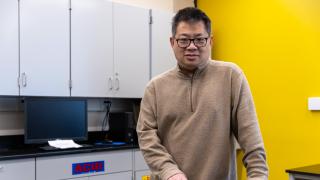
Over the past year, we’ve been writing more about interdisciplinary research, both in terms of specific projects (see, for example, our recent series on autonomous vehicles) and as a strategy for pushing UM-Dearborn’s research enterprise into its next growth phase. The reason why interdisciplinary research is so hot right now is that many of society’s most pressing problems (e.g. climate change, mobility and inequality) are simply too complex for a single expert to tackle on their own. As a result, big funders are increasingly looking for teams of researchers from different disciplines to pitch complex projects that demonstrate innovative solutions and community partnerships that can prove those ideas. It’s an exciting shift for sure. But creating an environment where multidisciplinary teams can develop and thrive turns out to be a complex challenge for most universities.
There are a number of reasons why interdisciplinary research may not just happen naturally on a campus, according to Assistant Director of Research Development Vessela Vassileva-Clarke. One of the main factors is the specialized nature of academic expertise itself. When a faculty member is starting their career, they have to establish expertise in novel areas, which usually requires a good deal of specialization. (Think, for example, how specific the titles of dissertations or journal articles are.) As faculty develop that expertise, it’s natural to encounter and collaborate with people of similar interests, who are working to advance the discipline as well. “But crossing boundaries is not so easy,” Vassileva-Clarke says. “In reality, it often takes a specific opportunity, or problem, or a moment where a researcher realizes their own expertise is not enough.” This, she says, may also be why interdisciplinary research is more common among established faculty. Junior faculty are still developing their expertise and journeying toward their creative limits, not bumping up against them. Additionally, it may be riskier professionally for younger faculty to veer off a specialized path, given that establishing one’s publishing chops is crucial to earning tenure.
Beyond these general issues, institutions sometimes face challenges more specific to their history or culture, says Vice Provost for Research Armen Zakarian. Take UM-Dearborn for example. Our university was founded back in 1959 as part of an innovative collaboration between the University of Michigan and Ford Motor Co., with hopes that the partnership would produce practical benefits for both institutions. We’ve grown a lot since, both in size and focus, but Zakarian says that until very recently, the vast majority of our research was still supported by industry partnerships. He says most industry-funded work is highly specific, and hence deals with problems that don’t generally require more than a single principal investigator (PI). And because that industry-funded strategy has served UM-Dearborn’s research enterprise well for decades, we simply don’t have a lot of experience in the interdisciplinary research space. “It’s not that we’ve done something wrong, it’s just that’s what we were — and to some extent still are,” Zakarian says. “Historically, we’ve just had very little cross-unit collaboration in developing or writing proposals for federal agencies. So for us to be successful at that level, we need to find ways to stimulate that kind of collaboration.”
In recent years, UM-Dearborn has been trying to nurture that interdisciplinary energy in a variety of ways. Events like faculty “research slams” give researchers a chance to hear what their colleagues from other colleges are doing. Our researchers have also frequently participated in the U-M MCubed program, which provides smaller internal grants to multidisciplinary teams. And some newly launched interdisciplinary research groups are giving faculty a platform for exploring overlapping interests. (So far, faculty have organized groups around additive manufacturing, education research and curriculum innovation, and reinstating public trust in technology and science.)
But to push this effort to the next level, the Office of Research is offering a new program that formally “incentivizes” collaborations specifically targeting interdisciplinary team grants from external national funders. Notably, these new Thematic Research Planning Grants don’t fund the research itself, but research planning. To apply, faculty teams must represent at least two academic units; have identified a specific external funding opportunity they’d like to go after as well as relevant community partners; outline the scope of their project and its impact; and evaluate the likelihood of success. “This is not just an occasion to get together and discuss ideas. We are funding teams that have strong proposal ideas and want help going after a specific external funding opportunity,” Vassileva-Clarke says. “Looking forward, we hope this opportunity serves as a platform where they’ll discover even more areas for collaboration so they can continue their interdisciplinary work far into the future.” In other words, they hope the program serves as an incubator for a more convergent research culture on campus.
To scaffold this experience for faculty, the Office of Research has identified three themes for the initial round of Thematic Research Planning Grant funding. This year’s themes are sustainability, mobility and infrastructure, and diversity, equity and inclusion. Zakarian says they zeroed in on these subjects because they overlap areas of interdisciplinary strength among our faculty ranks and topics that are of high interest to external funders. Teams approved for Thematic Research Planning Grant funding get 12 months to plan, collect necessary preliminary data, and write their proposals. They’ll also get the full support of the Office of Research staff, who can provide detailed guidance on proposal writing and communicating with funders.
“Given our history, I think we’ve been primed for the single-PI proposals, and we’ve had a lot of success with that,” Zakarian says. “But now we are reaching a point where we can compete at another level. Developing those relationships among faculty doesn’t happen without nurturing. So we are very enthusiastic about supporting our faculty in what I expect will be an exciting chapter in our history.”
###
Are you a faculty member interested in applying for one of the Thematic Research Planning Grants? The next application deadline is Feb. 15, 2022, with another round of proposals due June 15. You can find more details about the program.





